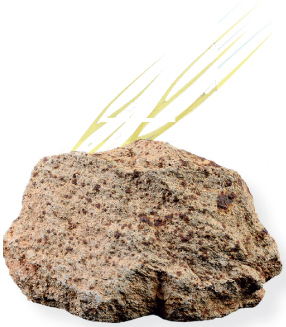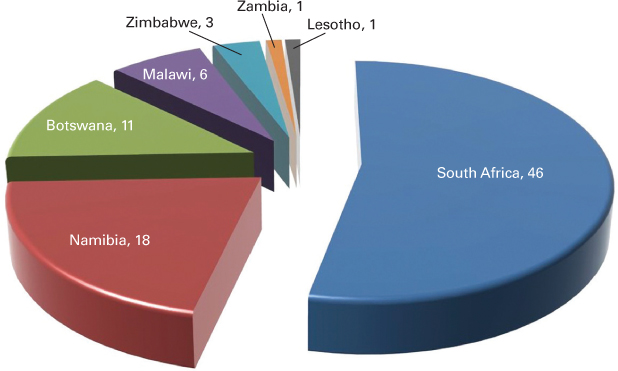

This section focuses primarily on the meteorite situation in southern Africa, where the laws regarding the collection and trade in meteorites are particularly onerous and quite unlike the laws in most other countries around the world.
In South Africa, Namibia and Botswana all new meteorites belong to the government of the country in which they are found, and are protected by law. In other words, all South African meteorites found since the legislation was promulgated belong to the South African government and, similarly, all meteorites from Namibia and Botswana found after the legislation was introduced to those countries belong to their respective governments (unless a permit has been granted in specific cases). In South Africa, the Act that governs items deemed to be of heritage value is the South African Heritage Act No. 26 of 1999. South African meteorites may not be collected, removed, exported, traded, bought or sold without a permit issued by the South African Heritage Agency. The same legislation applies to meteorites from Namibia and Botswana.
The Gibeon meteorite from Namibia perhaps deserves some mention here since it is, without doubt, one of the most common meteorites in the world and is a popular member of almost every meteorite collection. Namibia was formerly called South West Africa, and fell under South Africa’s legal system until it became independent in 1990. Many tons of Gibeon meteorites were recovered and exported to museums and collections around the world in the early 1900s before any of the current legislation was promulgated. Virtually every museum or private collector in the world with a meteorite collection has at least one Gibeon specimen in their collection. The largest Gibeon recovered, of over 680kg, currently resides in the Iziko South African Museum in Cape Town, to which it was donated in the early 1900s.
Until recently, it was also possible to search for meteorites in Lesotho and to export any found. In 2013, however, Lesotho introduced legislation similar to that of South Africa, making it illegal to move or export Lesotho meteorites from the country. As with the South African and Namibian legislation, however, the new Lesotho legislation cannot be applied retrospectively. The many hundreds of collectors around the world who purchased pieces of the Thuathe meteorite shortly after the 2002 fall in Lesotho need not be concerned, as no laws have been broken. The new legislation applies only to meteorites found after January 2013, or any that are still based in Lesotho, since it is now illegal to take them out of the country.

Distribution of meteorites in southern Africa by number
Fortunately, the meteorite laws are relevant only to the specific meteorites of the countries themselves and do not cover meteorites from any other countries. It is therefore completely legal and acceptable to collect, buy and sell meteorites in South Africa, for example, as long as the meteorites being traded or collected do not include South African meteorites (of which only 46 or so are known to exist).
The breakdown of meteorites found in southern Africa is shown in the chart above. When the actual weights of the recovered meteorites are taken into consideration, the distribution picture changes considerably, as can be seen in the chart on page 79. The reason for the difference is that the largest single meteorite in the world (Hoba) as well as one of the largest known strewn fields of iron meteorites (Gibeon) both occur in Namibia, and the combined weight of around 112t completely dominates the comparison when based on weight. It should be noted that the original total known weight of the Gibeon meteorite is listed at 26t, and has been doubled to 52t based on the views of various collectors and dealers who have bought or sold Gibeon meteorites over a period of many years. The actual weight of Gibeon meteorite in collections around the world may be much higher and is impossible to quantify accurately.
Budding meteorite collectors in South Africa should therefore not despair; they can still enjoy collecting meteorites from elsewhere in the world, since there are now over 14,600 different meteorite falls or finds worldwide, of which only 46 are out of bounds in South Africa. If you live in Namibia, only 18 are out of bounds. It should also be remembered that a single fall or find will often involve 1,000 or more individual meteorites or fragments – in some cases it can be less but in most cases it will be significantly more. There is no problem regarding the purchase or sale of meteorites from Namibia in South Africa and vice versa, and Gibeon meteorites from Namibia, for example, are often available for sale in South Africa, just as they are widely available for sale in Europe and the USA.
Prior to the 1999 introduction of the South African Heritage legislation on meteorites, 46 registered meteorites had been classified and are available for academic examination in museums around the country. Since the legislation was introduced, however, no new meteorites have been identified or handed in to the state for safekeeping or classification. During the same period, more than 5,000 different meteorite falls and finds (comprising many millions of individual stones) have been found and classified in northwest Africa, which not only allows searching for meteorites, but encourages the activity as it creates employment opportunities for local nomads who have no other means of generating income.
If you do think you may have found a meteorite, the best option is to take a digital photo of the specimen and send it to a museum or to the author who will likely be able to identify it from the photograph.
How old are meteorites?
If a meteorite has not been altered in some way from the time it was initially formed, it will typically be around 4.56 billion years old and can be dated accurately to within 2 million years. Most of the Martian meteorites recovered so far tend to be in the order of 1.3 billion years old, which corresponds with the last major volcanic eruptions on the planet. Lunar meteorites tend to be between 3.3 and 3.7 billion years old if they originated from the more recent basaltic areas or the older highland areas, respectively.